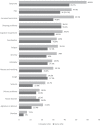End of life in patients attended by pediatric palliative care teams: what factors influence the place of death and compliance with family preferences?
- PMID: 36890334
- PMCID: PMC10175312
- DOI: 10.1007/s00431-023-04870-z
End of life in patients attended by pediatric palliative care teams: what factors influence the place of death and compliance with family preferences?
Abstract
Each year, more than 8 million children worldwide require specialized palliative care, yet there is little evidence available in pediatrics on the characteristics of the end of life in this context. Our aim is to analyze the characteristics of patients who die in the care of specific pediatric palliative care teams. This is ambispective, analytical observational, multicenter study conducted between 1 January and 31 December 2019. Fourteen specific pediatric palliative care teams participated. There are 164 patients, most of them suffering from oncologic, neurologic, and neuromuscular processes. The follow-up time was 2.4 months. The parents voiced preferences in respect of the place of death for 125 of the patients (76.2%). The place of death for 95 patients (57.9%) was at the hospital and 67 (40.9%) was at home. The existence of a palliative care team for over 5 years is more likely to be related to families voicing preferences and their fulfillment. Longer follow-up times by pediatric palliative care teams were observed in families with whom preferences regarding the place of death were discussed and in patients who died at home. Patients who did not receive home visits, when the pediatric palliative care team did not provide full care and when preferences regarding the place of death were not discussed with parents, were more likely to die in the hospital. Conclusions: Advance planning of end-of-life care is one of the most important aspects of pediatric palliative care. The provision of services by the teams and the follow-up time are related to parents' expressed preferences and the place of death. What is Known: • Various studies have shown how the availability of pediatric palliative care services improves the quality of life of patients and their families while reducing costs. • The place of death is an important factor influencing the quality of end-of-life care for dying people. The increase in palliative care teams increases the number of deaths in the home and having this care available 24/7 increases the probability of dying at home. What is New: • Our study identifies how a longer follow-up time of patients by palliative care teams is significantly associated with death at home and with express and comply with the preferences expressed by families. • Home visits by the palliative care team increase the likelihood that the patient will die at her home and that the preferences expressed by the palliative care team families will be cared for.
Keywords: Advance directives; Child mortality; Decision-making; Infant death palliative care; Right to die; Terminal care.
© 2023. The Author(s).
Conflict of interest statement
The authors declare no competing interests.
Figures
Similar articles
-
Prescription of Controlled Substances: Benefits and Risks.2025 Jul 6. In: StatPearls [Internet]. Treasure Island (FL): StatPearls Publishing; 2025 Jan–. 2025 Jul 6. In: StatPearls [Internet]. Treasure Island (FL): StatPearls Publishing; 2025 Jan–. PMID: 30726003 Free Books & Documents.
-
Community and hospital-based healthcare professionals perceptions of digital advance care planning for palliative and end-of-life care: a latent class analysis.Health Soc Care Deliv Res. 2025 Jun 25:1-22. doi: 10.3310/XCGE3294. Online ahead of print. Health Soc Care Deliv Res. 2025. PMID: 40580081
-
Falls prevention interventions for community-dwelling older adults: systematic review and meta-analysis of benefits, harms, and patient values and preferences.Syst Rev. 2024 Nov 26;13(1):289. doi: 10.1186/s13643-024-02681-3. Syst Rev. 2024. PMID: 39593159 Free PMC article.
-
Home treatment for mental health problems: a systematic review.Health Technol Assess. 2001;5(15):1-139. doi: 10.3310/hta5150. Health Technol Assess. 2001. PMID: 11532236
-
A rapid and systematic review of the clinical effectiveness and cost-effectiveness of paclitaxel, docetaxel, gemcitabine and vinorelbine in non-small-cell lung cancer.Health Technol Assess. 2001;5(32):1-195. doi: 10.3310/hta5320. Health Technol Assess. 2001. PMID: 12065068
Cited by
-
Evaluating quality of life in pediatric palliative care: a cross-sectional analysis of children's and parents' perspectives.Eur J Pediatr. 2024 Mar;183(3):1305-1314. doi: 10.1007/s00431-023-05330-4. Epub 2023 Dec 19. Eur J Pediatr. 2024. PMID: 38112799 Free PMC article.
-
Pediatric palliative care in Brazil: reflections on end of life based on geographic mapping.Res Health Serv Reg. 2024 Nov 28;3(1):18. doi: 10.1007/s43999-024-00054-w. Res Health Serv Reg. 2024. PMID: 39604648 Free PMC article.
-
Stress Factors for the Paediatric and Adult Palliative Care Multidisciplinary Team and Workplace Wellbeing Solutions.Healthcare (Basel). 2024 Apr 23;12(9):868. doi: 10.3390/healthcare12090868. Healthcare (Basel). 2024. PMID: 38727425 Free PMC article.
-
Decision-making regarding place of end-of-life care for children with life-limiting and life-threatening conditions: a systematic integrative review.BMC Palliat Care. 2025 Jan 27;24(1):24. doi: 10.1186/s12904-025-01661-1. BMC Palliat Care. 2025. PMID: 39871212 Free PMC article.
-
Economic costs of health and social care for a child with a life-limiting condition in their last year of life: a systematic review.BMJ Paediatr Open. 2025 Jul 16;9(1):e003526. doi: 10.1136/bmjpo-2025-003526. BMJ Paediatr Open. 2025. PMID: 40670044 Free PMC article. Review.
References
-
- Benini F, Papadatou D, Bernadá M, Craig F, De Zen L, Downing J et al (2022) International standards for pediatric palliative care: from IMPaCCT to GO-PPaCS. J Pain Symptom Manage - PubMed
-
- Palliative care [Internet]. [cited March 31, 2022]. Available at: https://www.who.int/health-topics/palliative-care
Publication types
MeSH terms
LinkOut - more resources
Full Text Sources
Medical


